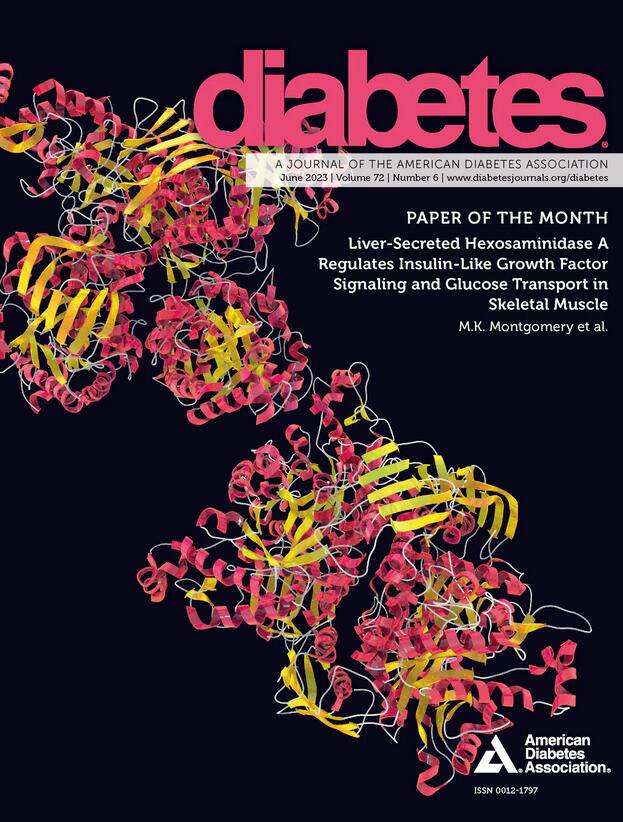库欣综合征、高皮质醇血症和葡萄糖稳态:综述
IF 7.5
1区 医学
Q1 ENDOCRINOLOGY & METABOLISM
引用次数: 0
摘要
直到最近,人们一直认为内源性库欣综合征的患病率很低。然而,随着诊断策略的改进和意识的提高,我们对高皮质醇症及其在2型糖尿病、肥胖、高血压和心血管疾病的病理生理学中的作用的理解得到了拓宽。最近来自欧洲、南美和美国的研究表明,尽管使用多种降糖药治疗,但仍有很大比例的难以控制的2型糖尿病患者患有高皮质醇血症,这是他们管理不善的糖尿病的一个致病因素。在这篇综述中,我们研究了过量皮质醇导致葡萄糖稳态损害的病理生理机制,并建议将高皮质醇症添加到不祥八组中,形成有害九组,作为2型糖尿病发展的病理生理基础。高皮质醇血症作为2型糖尿病发展的一个致病因素很少受到关注。来自欧洲、南美和美国的研究表明,尽管接受了多种降糖药治疗,但仍有很大一部分管理不善的2型糖尿病患者内源性皮质醇分泌过多,这是导致高血糖的一个因素。动物和人类的体内和体外研究表明,过量暴露于糖皮质激素可促进肌肉、肝脏和脂肪细胞的胰岛素抵抗,并损害胰岛素分泌。我们提出了一个回响循环,在这个循环中,高皮质醇血症破坏了正常的昼夜节律,导致胰岛素抵抗和高胰岛素血症,这反过来又进一步破坏了下丘脑-垂体-肾上腺轴。本文章由计算机程序翻译,如有差异,请以英文原文为准。
Cushing Syndrome, Hypercortisolism, and Glucose Homeostasis: A Review
Until recently, the prevalence of endogenous Cushing syndrome has been considered to be low. However, improved diagnostic strategies and increased awareness have broadened our understanding of hypercortisolism and its role in the pathophysiology of type 2 diabetes, obesity, hypertension, and cardiovascular disease. Recent studies from Europe, South America, and the U.S. have demonstrated that a significant percentage of individuals with difficult-to-control type 2 diabetes, despite treatment with multiple glucose-lowering agents, have hypercortisolism as a causative factor in their poorly managed diabetes. In this review, we examine the pathophysiologic mechanisms via which excess cortisol contributes to the impairment in glucose homeostasis and recommend that hypercortisolism be added to the Ominous Octet to form the Noxious Nine as the pathophysiologic foundation for the development of type 2 diabetes. ARTICLE HIGHLIGHTS Hypercortisolism as a causative factor in the development of type 2 diabetes has received scant attention. Studies from Europe, South America, and the U.S. have demonstrated that a significant percentage of individuals with poorly managed type 2 diabetes, despite treatment with multiple glucose-lowering agents, have endogenous hypersecretion of cortisol as a causative factor for their hyperglycemia. In vivo and in vitro studies in animals and humans have demonstrated that excess exposure to glucocorticoids can promote insulin resistance in muscle, liver, and adipocytes and impair insulin secretion. We propose a reverberating cycle in which hypercortisolism disrupts the normal circadian rhythm causing insulin resistance and hyperinsulinemia, which in turn further disrupts the hypothalamic-pituitary-adrenal axis.
求助全文
通过发布文献求助,成功后即可免费获取论文全文。
去求助
来源期刊

Diabetes
医学-内分泌学与代谢
CiteScore
12.50
自引率
2.60%
发文量
1968
审稿时长
1 months
期刊介绍:
Diabetes is a scientific journal that publishes original research exploring the physiological and pathophysiological aspects of diabetes mellitus. We encourage submissions of manuscripts pertaining to laboratory, animal, or human research, covering a wide range of topics. Our primary focus is on investigative reports investigating various aspects such as the development and progression of diabetes, along with its associated complications. We also welcome studies delving into normal and pathological pancreatic islet function and intermediary metabolism, as well as exploring the mechanisms of drug and hormone action from a pharmacological perspective. Additionally, we encourage submissions that delve into the biochemical and molecular aspects of both normal and abnormal biological processes.
However, it is important to note that we do not publish studies relating to diabetes education or the application of accepted therapeutic and diagnostic approaches to patients with diabetes mellitus. Our aim is to provide a platform for research that contributes to advancing our understanding of the underlying mechanisms and processes of diabetes.
 求助内容:
求助内容: 应助结果提醒方式:
应助结果提醒方式:


